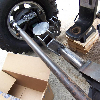bonesy
Member
- Joined
- July 17, 2009
- Messages
- 16
- Reaction score
- 0
- City, State
- DC
- Year, Model & Trim Level
- 1996 5.0L Eddie Bauer
So my AC has stumped me, the clutch is not engaging at all. Here is what I have noticed --
Purple Wire from Electronic Automatic Temperature's Clutch Out -- fluctuates between 0 - 12 V (expected)
Red/Yellow Wire after AC Clutch Cycling Pressure Switch -- fluctuates between 0 - 10 V (expected, but not why 12 V, is it because the resistance in the switch?)
DK Green/Orange in the WOT AC Relay Seat -- fluctuates between 0 - 3 V (why such a big drop, resistance in the switches?)
Jump the AC Clutch Cycling Pressure Switch -- no difference to clutch engaging or V @ DK Green/Orange in the WOT AC Relay Seat
Jump WAC Switch -- no difference to clutch engaging -- no difference to clutch engaging or V @ DK Green/Orange in the WOT AC Relay Seat
Connect DK Green/Orange in the WOT AC Relay Seat to 12V Battery -- CLUTCH ENGAGES!
The current low pressure is about ~60 psi, on the gage I have right on the boarder of Green/Red Zones.
Do not have a fitting for the tube from the the WAC Switch, so I do not have the pressure there.
I have rotated the relays in the distribution box, no change.
When I connect the Purple Wire directly to the Relay, there is a voltage difference (?). Meaning, when the purple wire not connected it fluctuates between 0-12V but when it is connected it fluctuates between 0 - 3 V. From good old physics, Volts = Amp X Ohms; aren't volts and ohms fixed in this case, so only amps should change? If so, then why would I be seeing this drop in volts on this direct connection? Is this my problem: once it is connected to the relay, I no longer have the necessary potential to activate the relay whereas if I hook it to the battery I do?
The only thing left in the circuit is the PCM, would this be causing so issue or the drop in voltage of the direct connection?
Thanks for any help, I am getting tired of coming home from work with a sweat drenched shirt even with windows down.
Purple Wire from Electronic Automatic Temperature's Clutch Out -- fluctuates between 0 - 12 V (expected)
Red/Yellow Wire after AC Clutch Cycling Pressure Switch -- fluctuates between 0 - 10 V (expected, but not why 12 V, is it because the resistance in the switch?)
DK Green/Orange in the WOT AC Relay Seat -- fluctuates between 0 - 3 V (why such a big drop, resistance in the switches?)
Jump the AC Clutch Cycling Pressure Switch -- no difference to clutch engaging or V @ DK Green/Orange in the WOT AC Relay Seat
Jump WAC Switch -- no difference to clutch engaging -- no difference to clutch engaging or V @ DK Green/Orange in the WOT AC Relay Seat
Connect DK Green/Orange in the WOT AC Relay Seat to 12V Battery -- CLUTCH ENGAGES!
The current low pressure is about ~60 psi, on the gage I have right on the boarder of Green/Red Zones.
Do not have a fitting for the tube from the the WAC Switch, so I do not have the pressure there.
I have rotated the relays in the distribution box, no change.
When I connect the Purple Wire directly to the Relay, there is a voltage difference (?). Meaning, when the purple wire not connected it fluctuates between 0-12V but when it is connected it fluctuates between 0 - 3 V. From good old physics, Volts = Amp X Ohms; aren't volts and ohms fixed in this case, so only amps should change? If so, then why would I be seeing this drop in volts on this direct connection? Is this my problem: once it is connected to the relay, I no longer have the necessary potential to activate the relay whereas if I hook it to the battery I do?
The only thing left in the circuit is the PCM, would this be causing so issue or the drop in voltage of the direct connection?
Thanks for any help, I am getting tired of coming home from work with a sweat drenched shirt even with windows down.










